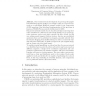Free Online Productivity Tools
i2Speak
i2Symbol
i2OCR
iTex2Img
iWeb2Print
iWeb2Shot
i2Type
iPdf2Split
iPdf2Merge
i2Bopomofo
i2Arabic
i2Style
i2Image
i2PDF
iLatex2Rtf
Sci2ools
IPPS
1999
IEEE
1999
IEEE
Process Networks as a High-Level Notation for Metacomputing
Abstract. Our work involves the development of a prototype Geographical Information System GIS as an example of the use of process networks as a well-de ned high-level semantic model for the composition of GIS operations. Our Java-based implementation of this prototype is known as PAGIS Process network Architecture for GIS. Our process networks consist of a set of nodes and edges connecting those nodes assembled as a Directed Acyclic Graph DAG. In our prototype, nodes represent services and edges represent the ow of data in this case sub-processed imagery between services. Services are pre-de ned operations that can be performed on imagery, presently selected from the Generic Mapping Tools GMT library. In order to control the start and end-point of the DAG, we de ne an input node the original image and an output node the result image. To exploit potential parallelism, we extend our idea of a process network to a distributed process network, where each service may be processed on di ere...
Distributed And Parallel Computing | IPPS 1999 | Process Network | Process Network Architecture | Prototype Geographical Information |
| Added | 03 Aug 2010 |
| Updated | 03 Aug 2010 |
| Type | Conference |
| Year | 1999 |
| Where | IPPS |
| Authors | Darren Webb, Andrew L. Wendelborn, Kevin Maciunas |
Comments (0)

